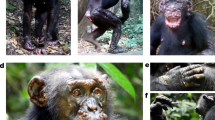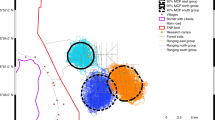Abstract
Infectious disease has joined habitat loss and hunting as threats to the survival of the remaining wild populations of great apes. Nevertheless, relatively little is known about the causative agents1,2,3. We investigated an unusually high number of sudden deaths observed over nine months in three communities of wild chimpanzees (Pan troglodytes verus) in the Taï National Park, Ivory Coast. Here we report combined pathological, cytological and molecular investigations that identified Bacillus anthracis as the cause of death for at least six individuals. We show that anthrax can be found in wild non-human primates living in a tropical rainforest, a habitat not previously known to harbour B. anthracis. Anthrax is an acute disease that infects ruminants4,5, but other mammals, including humans, can be infected through contacting or inhaling high doses of spores or by consuming meat from infected animals6. Respiratory and gastrointestinal anthrax are characterized by rapid onset, fever, septicaemia and a high fatality rate without early antibiotic treatment6,7. Our results suggest that epidemic diseases represent substantial threats to wild ape populations, and through bushmeat consumption also pose a hazard to human health.
This is a preview of subscription content, access via your institution
Access options
Subscribe to this journal
Receive 51 print issues and online access
$199.00 per year
only $3.90 per issue
Buy this article
- Purchase on Springer Link
- Instant access to full article PDF
Prices may be subject to local taxes which are calculated during checkout

Similar content being viewed by others
References
Wolfe, N. D. et al. Wild primate populations in emerging infectious disease research: The missing link? Emerg. Infect. Dis. 4, 149–158 (1998)
Ferber, D. Human diseases threaten great apes. Science 289, 1277–1278 (2000)
Walsh, P. D. et al. Catastrophic ape decline in western equatorial Africa. Nature 422, 611–614 (2003)
Smith, K. L. et al. Bacillus anthracis diversity in Kruger National Park. J. Clin. Microbiol. 38, 3780–3784 (2000)
Turnbull, P. C. B., Doganay, M., Lindeque, P. M., Aygen, B. & McLaughlin, J. Serology and anthrax in humans, livestock and Etosha National Park wildlife. Epidemiol. Infect. 108, 299–313 (1992)
Sirisanthana, T. & Brown, A. E. Anthrax of the gastrointestinal tract. Emerg. Infect. Dis. 8, 649–651 (2002)
Beatty, M. E., Ashford, D. A., Griffin, P. M., Tauxe, R. V. & Sobel, J. Gastrointestinal anthrax: review of the literature. Arch. Intern. Med. 163, 2527–2531 (2003)
Hill, K., Boesch, C., Goodall, J., Pusey, A., Williams, J. & Wrangham, R. Mortality rates among wild chimpanzees. J. Hum. Evol. 40, 437–450 (2001)
Leroy, E. M. et al. Multiple Ebola virus transmission events and rapid decline of central African wildlife. Science 303, 387–390 (2004)
Formenty, P. et al. Ebola virus outbreak among wild chimpanzees living in a rain forest of Côte d'Ivoire. J. Infect. Dis. 179(Suppl. 1), 120–126 (1999)
Boesch, C. & Boesch-Achermann, H. The Chimpanzees of the Taï Forest: Behavioural Ecology and Evolution (Oxford Univ. Press, Oxford, 2000)
Ellerbrok, H. et al. Rapid and sensitive identification of pathogenic and apathogenic Bacillus anthracis by real-time PCR. FEMS Microbiol. Lett. 214, 51–59 (2002)
Andersen, G. L., Simchock, J. M. & Wilson, K. H. Identification of a region of genetic variability among Bacillus anthracis strains and related species. J. Bacteriol. 178, 377–384 (1996)
Jackson, P. J. et al. Characterisation of the variable-number tandem repeats in vrrA from different Bacillus anthracis isolates. Appl. Environ. Microbiol. 63, 1400–1405 (1997)
Keim, P. et al. Multiple-locus variable-number tandem repeat analysis reveals genetic relationships within Bacillus anthracis. J. Bacteriol. 182, 2928–2936 (2000)
Vasconcelos, D. et al. Pathology of inhalation anthrax in cynomolgus monkeys (Macaca fascicularis). Lab. Invest. 83, 1201–1209 (2003)
Boutin, J. P., Debonne, J. M. & Rey, J. L. Apparition du charbon humain en forêt Ivoirienne. Méd. Tropicale 45, 79–81 (1985)
Leendertz, F. H. et al. High variety of different STLV-1 strains in chimpanzees (Pan troglodytes verus) of the Taï National Park, Côte d'Ivoire. J. Virol. 78, 4352–4356 (2004)
Bailes, E. et al. Hybrid origin of SIV in chimpanzees. Science 300, 1713 (2003)
Hahn, B., Shaw, G. M., De Cock, K. M. & Sharp, P. M. AIDS as a zoonosis: scientific and public health implications. Science 287, 607–614 (2000)
Vigilant, L., Hofreiter, M., Siedel, H. & Boesch, C. Paternity and relatedness in wild chimpanzee communities. Proc. Natl Acad. Sci. USA 98, 12890–12895 (2001)
Drosten, C. et al. Rapid detection and quantification of RNA of Ebola and Marburg viruses, Lassa virus, Crimean-Congo hemorrhagic fever virus, Rift Valley fever virus, dengue virus, and yellow fever virus by real-time reverse transcription-PCR. J. Clin. Microbiol. 40, 2323–2330 (2002)
Acknowledgements
We thank the Ivorian authorities for long-term support, especially the Ministry of the Environment and Forests as well as the Ministry of Research, the directorship of the Taï National Park, and the Swiss Research Center in Abidjan. We are grateful to P. Emmerich and H. Schmitz at the Bernhard-Nocht-Institut for VHF analyses. For technical support we thank S. Yumlu, T. Deschner, E. Normand, S. Pociuli, H. Emmel, and also U. Erikli for copy editing. This work was supported by the Robert Koch-Institut and the Max-Planck-Gesellschaft.
Author information
Authors and Affiliations
Corresponding author
Ethics declarations
Competing interests
The authors declare that they have no competing financial interests.
Supplementary information
Supplementary Table 1
Characteristics of the chimpanzees analysed Supplementary Table 1 presents all chimpanzees that were analysed in this work with name, group age and sex. This list includes the date of death or disappearance, the observed symptoms and the results from anthrax diagnostics. (DOC 28 kb)
Rights and permissions
About this article
Cite this article
Leendertz, F., Ellerbrok, H., Boesch, C. et al. Anthrax kills wild chimpanzees in a tropical rainforest. Nature 430, 451–452 (2004). https://doi.org/10.1038/nature02722
Received:
Accepted:
Issue Date:
DOI: https://doi.org/10.1038/nature02722
This article is cited by
-
Zootherapy as a potential pathway for zoonotic spillover: a mixed-methods study of the use of animal products in medicinal and cultural practices in Nigeria
One Health Outlook (2022)
-
Multiple stages of evolutionary change in anthrax toxin receptor expression in humans
Nature Communications (2021)
-
Lethal coalitionary attacks of chimpanzees (Pan troglodytes troglodytes) on gorillas (Gorilla gorilla gorilla) in the wild
Scientific Reports (2021)
-
Social Network Predicts Exposure to Respiratory Infection in a Wild Chimpanzee Group
EcoHealth (2020)
-
Elevated neopterin levels in wild, healthy chimpanzees indicate constant investment in unspecific immune system
BMC Zoology (2019)
Comments
By submitting a comment you agree to abide by our Terms and Community Guidelines. If you find something abusive or that does not comply with our terms or guidelines please flag it as inappropriate.



